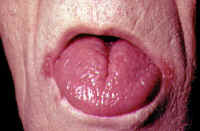| Contents
| Xerostomia |  |
The term xerostomia or dry mouth is generally used to indicate a dryness of the mouth resulting from diminished or arrested salivary secretion. It is not identical with hypo salivation. There is a variety of causes ranging from, insufficient capillary perfusion, drug related suppression of the innervation, auto immune breakdown and radiation effects to aplasia of the glands. The subjective sensations depend on quantity and quality of saliva. The lack of mucous secretion may result in a dry mouth experience in spite of normal parotid flow rates. The mucosal condition is of importance. A superficial mucositis due to candida albicans may be misunderstood as xerostomia. Even a propensity to frequent swallowing started up by hypo salivation can be mistaken as a sign of the opposite i.e. hyper salivation. On the other side xerostomia predisposes to a number of complaints such as burning, taste disorders, mucositis en dental caries. A dry mouth night and day should be regarded as a symptom leading to further investigation of the underlying cause. Sialometry of the parotid gland (with some exceptions) is well designed to define xerostomia in terms of reproducibility and inter individual comparison. See manual The time of latency between stimulus and protruding of saliva in the mouth is perhaps the best parameter to evaluate the condition of xerostomia. An increasing latency is generally linked to diminishing flow rates. The graph of this relation shows a turning point at a latency of 60 seconds correlating with a flow rate of 0.3 ml/min. Larger time lapses correspond with rapidly degressing flow rates. A latency of 1 minute is therefore a good indicator for xerostomia. This holds also for the longer latency period due to ductectasy in case of chronic recurrent parotitis which can be followed by a sudden flood of saliva. As the sensation of a dry mouth is the most prominent complaint leading to sialometry the related database is voluminous and will be sorted out in several capita. A good impression of the background is given in the provided chart.
|